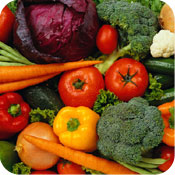 Around 6-8 months, your child will be able to hold a sippy cup. So this is a good time to offer your baby 100% fruit juice. Buy a covered baby cup with a spout and two handles. This will be easier for your baby to grab and hold. Do not worry if your baby cannot hold the cup. You can help guide it.
Around 6-8 months, your child will be able to hold a sippy cup. So this is a good time to offer your baby 100% fruit juice. Buy a covered baby cup with a spout and two handles. This will be easier for your baby to grab and hold. Do not worry if your baby cannot hold the cup. You can help guide it.
- Use juices such as 100% apple, pear, cherry, or grape. Look for juices with vitamin C added.
- Avoid sugary fruit drinks, fruit-flavored drinks, sweet tea, soft drinks, punches, lemonade or fruit-ades
- To protect your baby's teeth, never put the juice in a bottle. Use a sippy cup.
- Start with 1-2 ounces of fruit juice and gradually increase the amount to only 4 ounces each day. The natural fruit sugar may cause diarrhea in some babies, so you may want to dilute the juice to half strength in the beginning.
STEP 5: Texture changes
- When your baby has some teeth, it is time to start ground, mashed or chopped foods. Try adding soft, finely chopped fruits or cooked vegetables and ground or finely chopped meats. This will help your baby learn how to chew.
8-12 Months
- Now is a good time to start feeding your baby finger foods. Finger foods are small, bite-size pieces of food. Finger foods will help your baby learn how to feed himself and will help develop hand-eye coordination. Do not be surprised if he won't let you feed him any longer. Babies are very messy when they feed themselves. This is normal. Let your baby touch, smell and taste all kinds of foods. This will help him to explore and learn about food. Be patient.
- Your baby may also be interested in eating some of the family foods that are nutritious and easy to chew.
- Some suggested foods are: casseroles, scrambled eggs (after one year), dried beans or lentils (cooked and chopped), grilled cheese or meat (chicken, turkey, ham) sandwich pieces, meat loaf, mashed potatoes, mashed sweet potato or squash, homemade soup, cottage cheese, cut up soft vegetables, cut up canned fruit, yogurt, spaghetti, ground or finely chopped meats, cheese strips, well-cooked macaroni or pasta, soft bread, dry cereal or crackers.
A Guide to Feeding Your Baby
This food progression is based on the recommendations to help prevent food allergies from the American Academy of Asthma, Allergy, and Immunology (AAAAI) and the American Academy of Pediatrics (AAP).
Between the ages of 4-6 months, single-ingredient baby foods may be introduced such as rice and oat baby cereals, apples, pears, bananas, green vegetables, sweet potatoes, squash, and carrots. A new food can be introduced every 3-5 days as appropriate for baby's readiness. This slow progression gives parents or caregivers a chance to identify and eliminate any foods that cause a reaction.
Egg, cow's milk dairy foods, peanuts, tree nuts, fish and shellfish can be gradually introduced during this same 4-6 month time period after the less allergenic foods have been tolerated. In fact, delaying the introduction of foods like wheat, cow's milk dairy, eggs, fish and nuts may actually result in an increased risk of food allergy and eczema.
Sources:
http://www.niaid.nih.gov/topics/foodAllergy/clinical/Documents/FAguidelinesPatient.pdf
http://www.aaaai.org/practice-resources/statements-and-practice-parameters/practice-parameters-and-other-guidelines-page.aspx
http://www2.aap.org/sections/allergy/allergy_guidelines_final_1.pdf
|
 Around 6-8 months, your child will be able to hold a sippy cup. So this is a good time to offer your baby 100% fruit juice. Buy a covered baby cup with a spout and two handles. This will be easier for your baby to grab and hold. Do not worry if your baby cannot hold the cup. You can help guide it.
Around 6-8 months, your child will be able to hold a sippy cup. So this is a good time to offer your baby 100% fruit juice. Buy a covered baby cup with a spout and two handles. This will be easier for your baby to grab and hold. Do not worry if your baby cannot hold the cup. You can help guide it.






Member Comments